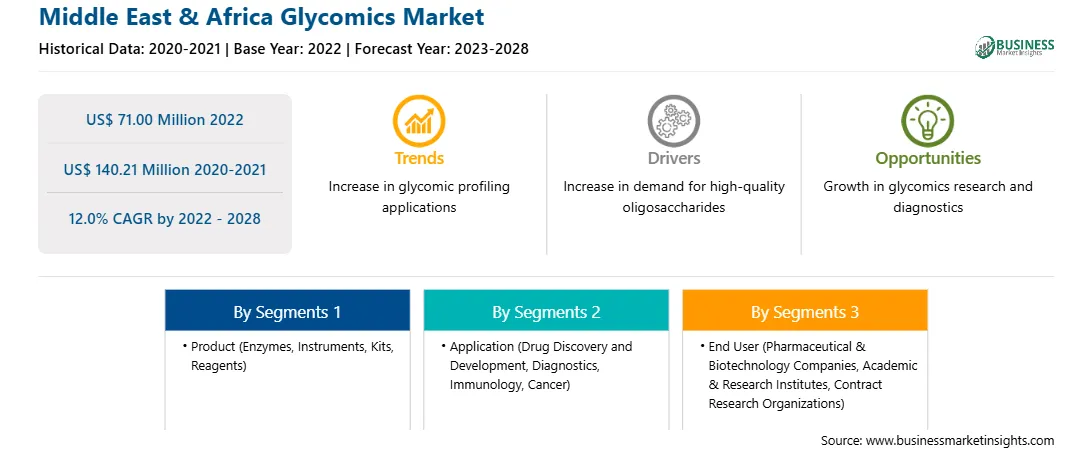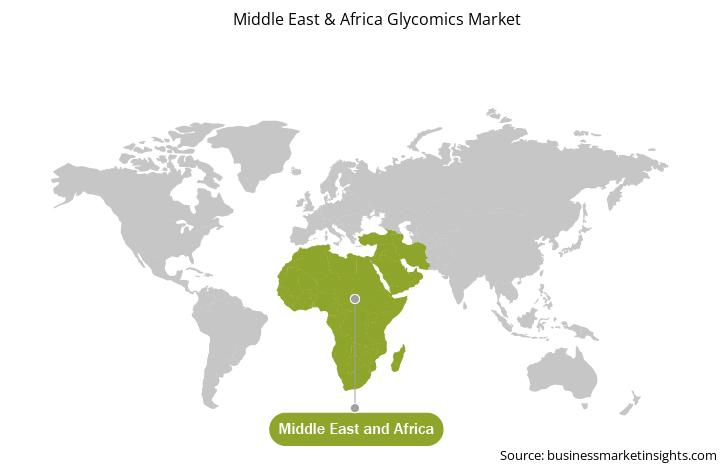The MEA glycomics market is expected to grow from US$ 71.00 million in 2022 to US$ 140.21 million by 2028; it is estimated to grow at a CAGR of 12.0% from 2022 to 2028.
Glycomics is a novel method for creating medicines. It draws on the knowledge that glycans serve as the primary means of altering numerous molecules in biological systems. This alteration provides those molecules with their complete, functional form. Glycans are found in most top-selling biologics and half of the therapeutic proteins (including antibodies against COVID-19). These proteins' glycans have been tailored to improve their effectiveness, lower the dosages required, and lessen negative effects. For instance, understanding the biological functions of glycans has led to their inclusion as essential ingredients in medications for the treatment of diabetes, the prevention of blood clotting, and the improvement of in vitro fertilization. Changes in the glycans on a microbe's surface are frequently connected to the microorganisms' resistance to popular medications. This property has been used in various ways, including detecting glycans in infection samples, disabling the protective biofilms formed by the infecting bacteria, and weakening the glycan-rich cell walls of microorganisms. More than 130 uncommon genetic illnesses, many of which are fatal in childhood, are brought on by errors in how human systems metabolize glycans. Understanding the glycans responsible for some of these problems has helped develop therapies. Because they can play a crucial role in how bacteria and viruses attack humans and escape our immune systems, glycans are employed in vaccinations. Additionally, more recent research on SARS-CoV-2 has shown infection pathways that depend on the virus's usage of human glycans. Glycans determine human blood types and reactions to organ transplants or blood transfusions. The blood or organ must match the blood group to be accepted. Therefore, greater adoption of glycomics in various research areas would eventually lead to a rise in the demand for these techniques, creating more research and developmental opportunities in the longer run.
With the new features and technologies, vendors can attract new customers and expand their footprints in emerging markets. This factor is likely to drive the MEA. The MEA is expected to grow at a good CAGR during the forecast period.
MEA Glycomics Market Revenue and Forecast to 2028 (US$ Million)
Strategic insights for the Middle East & Africa Glycomics provides data-driven analysis of the industry landscape, including current trends, key players, and regional nuances. These insights offer actionable recommendations, enabling readers to differentiate themselves from competitors by identifying untapped segments or developing unique value propositions. Leveraging data analytics, these insights help industry players anticipate the market shifts, whether investors, manufacturers, or other stakeholders. A future-oriented perspective is essential, helping stakeholders anticipate market shifts and position themselves for long-term success in this dynamic region. Ultimately, effective strategic insights empower readers to make informed decisions that drive profitability and achieve their business objectives within the market. The geographic scope of the Middle East & Africa Glycomics refers to the specific areas in which a business operates and competes. Understanding local distinctions, such as diverse consumer preferences (e.g., demand for specific plug types or battery backup durations), varying economic conditions, and regulatory environments, is crucial for tailoring strategies to specific markets. Businesses can expand their reach by identifying underserved areas or adapting their offerings to meet local demands. A clear market focus allows for more effective resource allocation, targeted marketing campaigns, and better positioning against local competitors, ultimately driving growth in those targeted areas.Middle East & Africa Glycomics Strategic Insights

Middle East & Africa Glycomics Report Scope
Report Attribute
Details
Market size in 2022
US$ 71.00 Million
Market Size by 2028
US$ 140.21 Million
Global CAGR (2022 - 2028)
12.0%
Historical Data
2020-2021
Forecast period
2023-2028
Segments Covered
By Product
By Application
By End User
Regions and Countries Covered
Middle East and Africa
Market leaders and key company profiles
Middle East & Africa Glycomics Regional Insights

MEA Glycomics Market Segmentation
The MEA glycomics market is segmented based on product, application, end user, and country. Based on product, the MEA glycomics market is segmented into enzymes, instruments, kits, and reagents. The enzymes segment dominated the market in 2022. The enzymes segment is further segmented into glycosidases, glycosyl transferases, sialyltransferases, neuraminidases, and others. The instruments segment is also segmented into mass spectrometers, MALDI-TOF, HPLC, lectin arrays, antibody arrays, and others. Similarly, the kits segment is segmented into glycan release kits, glycan labeling kits, glycan purification kits, and others. Furthermore, the reagents segment is segmented into oligosaccharides, monosaccharides, glycoproteins, and others. Based on application, the MEA glycomics market is segmented into drug discovery and development, diagnostics, immunology, cancer, and others. The drug discovery and development segment dominated the market in 2022. Based on end user, the MEA glycomics market is segmented into pharmaceutical & biotechnology companies, academic & research institutes, and contract research organizations. The pharmaceutical & biotechnology companies segment dominated the market in 2022. Based on country, the MEA glycomics market has been categorized into the UAE, Saudi Arabia, South Africa, and the Rest of MEA. Saudi Arabia dominated the market in 2022.
Agilent Technologies, Inc.; Bruker Corporation; MERCK KGaA; New England Biolabs; Shimadzu Corporation; Takara Bio Inc.; Thermo Fisher Scientific Inc.; and Waters Corporation are among the leading companies in the MEA glycomics market.
The Middle East & Africa Glycomics Market is valued at US$ 71.00 Million in 2022, it is projected to reach US$ 140.21 Million by 2028.
As per our report Middle East & Africa Glycomics Market, the market size is valued at US$ 71.00 Million in 2022, projecting it to reach US$ 140.21 Million by 2028. This translates to a CAGR of approximately 12.0% during the forecast period.
The Middle East & Africa Glycomics Market report typically cover these key segments-
The historic period, base year, and forecast period can vary slightly depending on the specific market research report. However, for the Middle East & Africa Glycomics Market report:
The Middle East & Africa Glycomics Market is populated by several key players, each contributing to its growth and innovation. Some of the major players include:
The Middle East & Africa Glycomics Market report is valuable for diverse stakeholders, including:
Essentially, anyone involved in or considering involvement in the Middle East & Africa Glycomics Market value chain can benefit from the information contained in a comprehensive market report.